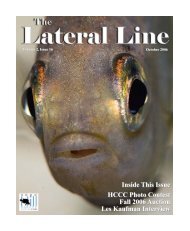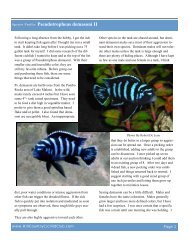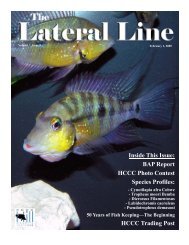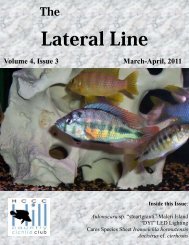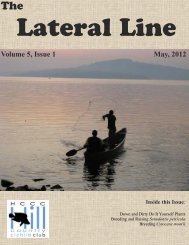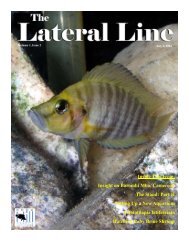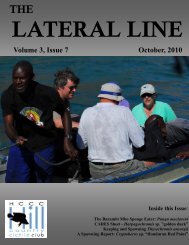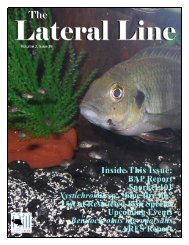Lateral Line August 2005.pub - Hill Country Cichlid Club
Lateral Line August 2005.pub - Hill Country Cichlid Club
Lateral Line August 2005.pub - Hill Country Cichlid Club
Create successful ePaper yourself
Turn your PDF publications into a flip-book with our unique Google optimized e-Paper software.
The <strong>Lateral</strong> <strong>Line</strong> Page 11strate spawners, preferring to lay their eggs onflat surfaces or within crevices formed byrocks, pots, etc.2) These fish will tend to be monogamous,forming bonded pairs that can last their lifetimes.3) Males within the majority of the speciestend to be larger in size, and more aggressiveand colorful in nature.4) Many New World cichlids are big fish, requiringlarge tanks to be appropriately housed.5) New Worlds favor tanks kept within therange of 76 to 82 degrees Fahrenheit, with pHlevels between 7.0 and 7.4. However, most arevery hardy and can withstand deviations fromthese standards.These displays show the genus, species, andcommon names, where appropriate, of manycichlids found in the Americas:Picture 1 (page 10): A male Amphilophus Citrinellus,of the striped color morph. This speciesexists in numerous color phases, includingstriped, white, yellow/gold, orange/red, andSouth AmericaGenus Species CommonAequidens Rivulatus True Green Terrorsp.cf. RivulatusGreen TerrorAmphilophus Festae Red TerrorAstronotus Ocellatus OscarCaquetaia Umbriferus UmbieHeros Severus SeverumPterophyllum Scalare AngelfishGenus Species CommonAmphilophus Citrinellus MidasLabiatusRed DevilArchocentrus Centrarchus FlyerNigrofasciatusConvictCichlasoma Trimaculatus TrimacCryptoherosCentral Americasp. “HonduranRed Point”Herichthys Carpinte Green TexasCarpinteCyanoguttatusTexasNandopsis Haitiensis OdoOctofasciatusTetracanthusJack DempseyCubanParachromis Dovii WolfManaguenseMotaguenseJaguarMotaThorichthys Meeki FiremouthVieja Maculicauda Black BeltSynspilusRed Headvarious combinations of these colors. Thisspecies is often confused with AmphilophusLabiatum, both of which are indiscriminatelycalled the "Red Devil." The Midas cichlid isfound in several locations across CentralAmerica, but is most often referred to as aninhabitant of Lake Nicaragua. Due to aquaristsreleasing their animals into the wild, Midascichlids can often be caught in the southernstates of the U.S., particularly in Florida.



